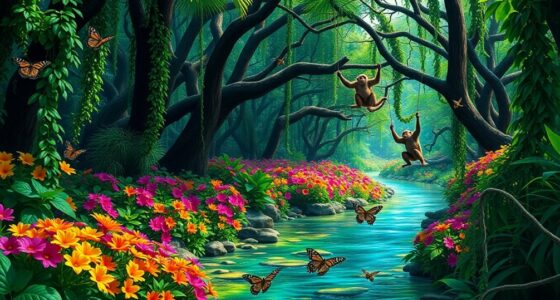Beneath the towering canopy of the Amazon rainforest lies a hidden world filled with secrets and vital ecosystems. As you explore this underground realm, you’ll discover how its intricate waterways and dark forest floor support countless species and maintain the forest’s health. Understanding these unseen layers reveals a complex web of life that’s crucial to Earth’s balance—and why protecting it matters more than ever.
The Layers of the Amazon Canopy
The Amazon canopy is a complex, multi-layered system that supports a vast array of life. You’ll find it divided into several distinct levels, each with unique characteristics. The emergent layer rises above the rest, where tall trees stretch toward the sun, creating a sparse but vital space for certain birds and insects. Beneath that’s the main canopy, forming a dense, interconnected roof of leaves that provides shelter and food for countless animals. Below, the understorey remains shaded and humid, perfect for insects and smaller predators. Finally, the forest floor lies in constant shadow, receiving minimal light. This layered structure creates a dynamic environment, influencing everything from sunlight penetration to species distribution, shaping the rich biodiversity that makes the Amazon so extraordinary. The different layers also facilitate species coexistence, allowing a multitude of organisms to thrive in close proximity without direct competition.
Unique Flora and Fauna of the Forest
Because the Amazon rainforest hosts such a diverse range of life, its flora and fauna are unlike anywhere else on Earth. You might spot the vibrant jaguar prowling silently through the undergrowth or catch a glimpse of the colorful macaw soaring above. The rainforest’s complex ecosystems are sustained by the abundant biodiversity that promotes resilience and adaptation among its species. The forest is home to extraordinary plants, like the giant water lily with leaves spanning over six feet and the ink-black orchids that bloom in hidden corners. You’ll also encounter unique creatures such as the Amazonian poison dart frog, whose bright colors warn predators, and the sloth, moving slowly in the treetops. Many species here are found nowhere else, adapting perfectly to this lush, competitive environment. Exploring this richness reveals the rainforest’s incredible ability to sustain a complex web of life.
The Role of Pollinators and Seed Dispersers
As you explore the Amazon’s rich biodiversity, you’ll notice that many plants rely on specific animals to reproduce and spread their seeds. Pollinators like hummingbirds, bats, and bees visit flowers, transferring pollen that helps plants produce fruit and seeds. Without them, many plants couldn’t reproduce, which impacts the entire ecosystem.
Seed dispersers, including monkeys, toucans, and agoutis, play a crucial role by carrying seeds away from parent trees. They often bury or drop seeds in new locations, helping plants colonize different areas. This mutual relationship ensures forest growth and diversity.
If pollinators or seed dispersers decline, it could threaten plant populations and the animals that depend on those plants. Their actions sustain the forest’s vibrant, interconnected web of life.
Hidden Waterways and Aquatic Ecosystems
Beneath the dense canopy of the Amazon rainforest lie hidden waterways that pulse with life and connect the ecosystem in unseen ways. These waterways, including intricate rivers, streams, and flooded forests, serve as vital corridors for countless species. Fish navigate these waters, some migrating long distances, ensuring genetic diversity and supporting local food chains. Nutrients flow through these channels, enriching soils and supporting lush plant growth. During the rainy season, floodwaters expand and submerge vast areas, creating temporary aquatic habitats teeming with life. You mightn’t see these waterways, but they influence the entire rainforest’s health, offering shelter, breeding grounds, and transportation routes. Their hidden presence sustains biodiversity and maintains the delicate balance of this extraordinary ecosystem. These waterways serve as crucial pathways for aquatic and terrestrial life, linking different parts of the ecosystem and enabling species movement and resilience.
Indigenous Knowledge and Conservation Efforts
Indigenous communities have long understood the Amazon rainforest’s intricate balance and rely on their deep-rooted knowledge to protect it. You benefit from generations of experience, knowing which plants heal, which animals indicate ecological changes, and how to sustainably harvest resources.
Your traditional practices often serve as conservation methods, like rotational farming that prevents deforestation or taboos that protect certain species. You act as stewards, maintaining biodiversity through cultural rituals and sustainable land management.
Many communities share their knowledge with scientists and environmental groups, fostering collaborative efforts to preserve the rainforest. Your understanding of the ecosystem’s complexities helps create effective conservation strategies rooted in local contexts. Additionally, traditional ecological knowledge provides valuable biodiversity insights that enhance scientific research and environmental policies.
Recognizing your role is vital, as it ensures the rainforest’s health for future generations.
Threats and Challenges Facing the Amazon Ecosystem
The Amazon rainforest faces numerous threats that threaten its delicate balance and global significance. Deforestation, driven by logging, agriculture, and infrastructure projects, destroys vast areas of habitat each year. This loss not only endangers countless species but also releases large amounts of carbon, worsening climate change.
Illegal mining contaminates rivers and harms ecosystems, while wildfires, often worsened by human activity, devastate large swaths of forest. Additionally, infrastructure development fragments habitats, making it harder for wildlife to survive.
You mightn’t see these impacts firsthand, but their effects ripple globally, influencing climate patterns and biodiversity. Addressing these challenges requires urgent action, sustainable policies, and a commitment to protecting this vital ecosystem for future generations. Utilizing innovative solutions like remote collaboration and engaging global communities can play a crucial role in conservation efforts.
Conclusion
By exploring the hidden world beneath the canopy, you see how vital every layer is to the Amazon’s health. Protecting this complex ecosystem requires your awareness and action. From tiny fungi to mighty rivers, each part plays a role in sustaining life. Your efforts to understand and conserve these secrets ensure the rainforest’s resilience for future generations. Together, we can preserve this extraordinary rainforest and its unseen wonders.




